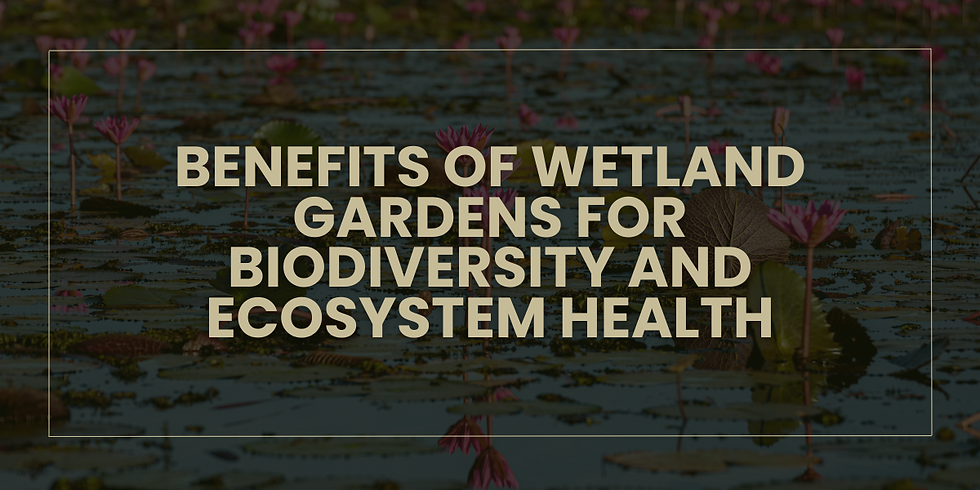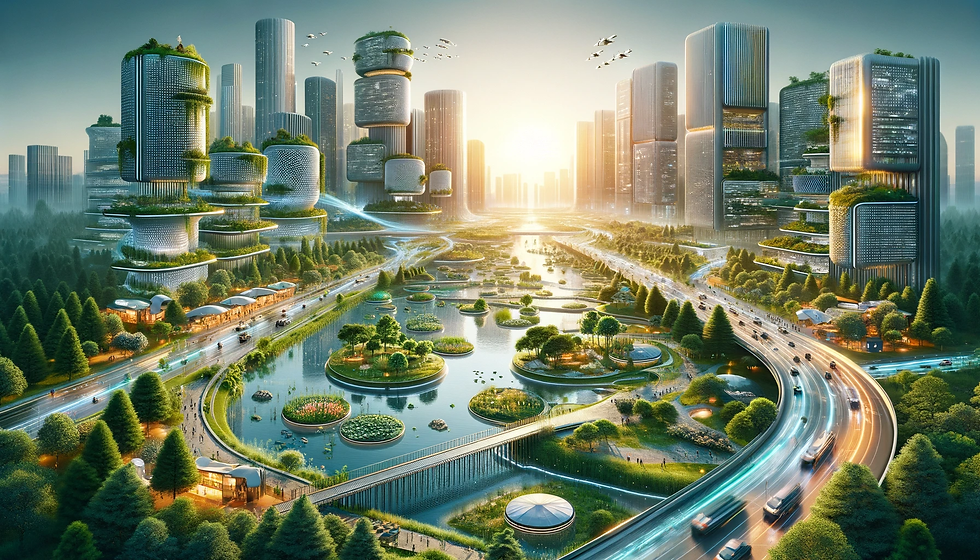
The Essence of Wetland Gardens
Wetland gardens, a concept often overlooked in traditional landscaping, stand at the forefront of conservation gardening. These unique ecosystems are not only aesthetically pleasing but play a crucial role in enhancing biodiversity and maintaining ecosystem health. The term 'wetland' conjures images of marshes, bogs, and swamps, environments that are teeming with life. Incorporating these elements into garden spaces creates wetland gardens - a haven for numerous species and a vital component of our ecological framework.
Biodiversity: A Symphony of Life
At the heart of a wetland garden is biodiversity - the variety of life in all its forms, levels, and combinations. Whether it's plants, animals, microorganisms, genetic materials, or ecosystems, biodiversity is the fabric that holds nature together. In the context of wetland gardens, biodiversity manifests in myriad forms, from the smallest aquatic invertebrates to the most majestic birds that visit these habitats.
Ecosystem Health: The Lifeline of Nature
Ecosystem health is a term that reflects the robustness and balance of an ecosystem. In wetland gardens, this translates to the presence of diverse native species, the absence of invasive species, and the natural processes that sustain life. Wetland gardens are pivotal in maintaining this balance. They serve as miniature ecosystems within our landscapes, providing essential services like water purification, habitat provision, and wildlife support.
Wetland Gardens: More Than Just Landscaping
The concept of wetland gardens transcends the traditional scope of gardening. It's an approach that integrates the principles of ecological importance, sustainable ecosystems, and wildlife habitats. These gardens are not just plots of land but are living, breathing ecosystems that contribute significantly to environmental well-being. They are a testament to the synergy between human creativity and nature's resilience.
The Role of Wetland Gardens in our Ecosystem
Wetland gardens play a multifaceted role in our environment. They are not just about creating a pleasing landscape but are about fostering a sustainable ecosystem. These gardens act as natural sponges, absorbing excess water during floods and releasing it during droughts, thereby regulating water flow and contributing to ecosystem services.
The importance of wetland gardens in ecosystem health cannot be overstated. They filter pollutants from water, provide habitat for a variety of species, and help in carbon sequestration, which is vital in combating climate change. By integrating wetland gardens into our landscapes, we are actively participating in wetland restoration and conservation efforts.
Wetland gardens are not mere ornamental features but are critical tools in preserving our planet's ecological balance. Their role in habitat provision, water purification, and wildlife support is invaluable. As we delve deeper into this topic, we will explore how these gardens contribute to biodiversity, their role in water purification, the wildlife habitats they create, and the conservation benefits they offer.
Key Benefits of Wetland Gardens for Biodiversity

Understanding the Impact on Local Biodiversity
Wetland gardens are a powerhouse of biodiversity. They create a mosaic of habitats that support various life forms. Here are some key benefits they offer:
Habitat Provision: Wetland gardens provide unique habitats for a range of species, from amphibians to birds, contributing significantly to ecosystem health.
Support for Pollinators: These gardens are a haven for pollinators, which are crucial for maintaining the health of natural habitats.
Diversity of Plant Life: They allow for the growth of a variety of native species, enhancing local biodiversity.
Role of Wetland Gardens in Water Purification
One of the standout roles of wetland gardens is in water purification. Here's how they contribute:
Natural Filtration: Wetland plants and soil microorganisms act as natural filters, removing pollutants from water.
Chemical Balance: They help in maintaining the chemical balance of water bodies by absorbing excess nutrients.
Creating Habitats for Wildlife
Wetland gardens are instrumental in enhancing wildlife habitats. They provide shelter, breeding grounds, and food sources for various species. This not only boosts local wildlife populations but also contributes to a more sustainable ecosystem.
Answering 'People Also Ask' Questions
What are the challenges in maintaining a healthy wetland garden?
How to design a wetland garden for maximum ecological benefit?
The Whimsical World of Wetland Gardens
Embark on a journey into the whimsical and often misunderstood world of wetland gardens. These natural wonderlands aren't just soggy patches of land, but rather bustling hubs of life, each with a story to tell. Let's dive into the nitty-gritty of these watery wonders and unearth some delightful insights.
The Eccentric Inhabitants of Wetland Gardens
Picture this: a garden where dragonflies dart, frogs chorus like a symphony, and birds flit about like feathery socialites at a gala. This isn't a scene from a whimsical nature documentary, but daily life in a wetland garden. Here, biodiversity isn't just a buzzword; it's a living, croaking, and fluttering reality.
Dragonfly Dens: Dragonflies are the acrobats of the insect world, and wetland gardens are their circuses. Watch them perform aerial stunts as they keep the mosquito population in check – nature's own pest control service!
Froggy Choirs: Frogs bring a melodious charm to these gardens. Each croak and ribbit is part of nature's symphony, creating a soundscape that's music to the ears of nature enthusiasts.
Bird Bistros: For birds, wetland gardens are the hippest eateries in town. They flock here not just for the ambiance but for the gourmet buffet of insects, seeds, and berries on offer.
Plant Performers and Their Secret Lives
In the realm of wetland gardens, plants are more than just green decor; they're dynamic performers in this ecological theater. Each species, from the towering cattails to the humble duckweeds, plays a critical role.
Cattails (Typha spp.): The skyscrapers of the wetland world, cattails are nature's answer to high-rise apartments for wildlife. They provide food, shelter, and nesting sites for a variety of creatures.
Duckweeds (Lemna spp.): These tiny floating plants are the minimalist artists of the wetland scene, creating a living tapestry on the water's surface. Plus, they're a superfood for waterfowl!
The Unsung Heroes: Microorganisms and Insects
Let's not forget the tiny but mighty residents of wetland gardens. Microorganisms and insects are the unsung heroes, working tirelessly behind the scenes. They decompose organic matter, pollinate plants, and keep the garden's life cycle spinning.
Wetland Gardens: The Ultimate Eco-Warriors
These gardens are more than just pretty faces in the landscaping world. They're hardworking eco-warriors fighting on the front lines of environmental conservation. By purifying water, sequestering carbon, and providing wildlife corridors, they're our allies in the battle against ecological decline.
Humor in Horticulture: The Lighter Side of Wetland Gardening
Who said gardening had to be all serious and no play? Wetland gardening comes with its share of giggles and chuckles. Ever seen a frog play leapfrog over lily pads? Or watched a squirrel perform a high-wire act on cattail stems? These gardens are nature's comedy clubs.
Answering More 'People Also Ask' Questions
How can wetland gardens aid in environmental conservation?
By being nature's kidneys! They filter out pollutants and provide habitats for endangered species, making them eco-heroes in their own right.
What native species thrive in wetland gardens?
What are the challenges in maintaining a healthy wetland garden?
The Global Stage: Wetland Gardens and Their Worldwide Influence
Think of wetland gardens as the unsung heroes of the global ecological theater. They're not just backyard projects but pivotal players in the worldwide campaign for environmental health. Here's why:
Climate Change Warriors: Wetland gardens are like nature's climate buffers, absorbing carbon and helping cool our planet.
International Migratory Stopovers: They're the ultimate rest stops for migratory birds, offering shelter and food on their global journeys.
The Wetland Garden Effect: Ripple Across Ecosystems
Every wetland garden contributes to a ripple effect across ecosystems. Like stones tossed in a pond, these gardens have far-reaching impacts:
Water Cycle Contributors: These gardens play a critical role in the local and global water cycles, acting as natural reservoirs and purifiers.
Biodiversity Boosters: By supporting a range of species, wetland gardens add to the richness and variety of life across the globe.
Quirky Facts About Wetland Gardens
Wetland gardens aren't just about science and stats; they're filled with quirky and amusing facts that add to their charm:
The Salamander Soirée: Did you know that some salamanders throw 'parties' in wetland gardens? These amphibious gatherings are crucial for their breeding rituals.
Plant Communication: Studies suggest that wetland plants might communicate through their root systems, creating an underground network of 'chatter'.
Addressing Common Misconceptions
Despite their importance, wetland gardens are often misunderstood.
Here's the truth behind common myths:
Myth: Wetland Gardens are Mosquito Breeding Grounds
Truth: When maintained properly, these gardens can control mosquito populations, thanks to natural predators like dragonflies and frogs.
Myth: Wetland Gardens Smell Bad
Truth: A healthy wetland garden is odor-free. Foul smells only arise if the ecosystem is out of balance.
Designing Wetland Gardens for Tomorrow
As we approach the crescendo of our wetland garden saga, let's ponder the future. Imagine designing wetland gardens that not only beautify our surroundings but also serve as pillars for ecological sustainability. Envision creating spaces where humans and nature coexist in harmony, each benefiting from the other's presence.
But wait, there's more! As we stand on the brink of ecological innovation, how can we harness the full potential of wetland gardens? What secrets do they hold for a sustainable future? Stay tuned for the final reveal, where we unlock the ultimate treasure trove of wetland garden wisdom.
Unveiling the Future of Wetland Gardens
As we conclude our journey through the enchanting realms of wetland gardens, it's time to gaze into the future and unravel how these vibrant ecosystems can shape our world. Beyond being mere elements of natural beauty, wetland gardens hold keys to ecological sustainability and a harmonious coexistence with nature.
The Future of Urban Landscapes: Integrating Wetland Gardens
In the quest for sustainable urban development, wetland gardens emerge as a beacon of hope. Imagine cities where these gardens are not just occasional sightings but integral elements of urban planning. They could transform concrete jungles into thriving eco-havens, offering:
Urban Wildlife Sanctuaries: Providing safe havens for urban wildlife, contributing to biodiversity even in densely populated areas.
Natural Flood Mitigation: Acting as natural sponges, these gardens can help prevent urban flooding, a growing concern in many cities.
Wetland Gardens and Climate Change: A Natural Solution
Amidst the escalating climate crisis, wetland gardens stand out as natural allies. Their ability to sequester carbon and regulate local climates is invaluable. By incorporating more of these ecosystems, we could significantly mitigate climate change effects. Key contributions include:
Carbon Storage: Wetland plants and soils are excellent at capturing and storing carbon, thus helping to reduce atmospheric CO2 levels.
Temperature Regulation: These gardens can cool surrounding areas, making them crucial in urban heat island mitigation.
Community Engagement: Bringing People and Nature Together
One of the most beautiful aspects of wetland gardens is their ability to connect people with nature. Community-driven wetland projects can foster a sense of stewardship and environmental awareness. They can serve as outdoor classrooms, spaces for ecological research, and hubs for community bonding.
Challenges and Innovations in Wetland Garden Design
As we embrace wetland gardens, we must also navigate the challenges they present. Innovations in sustainable design, like using native plants and creating self-sustaining water systems, are crucial. Overcoming challenges such as space constraints in urban areas and managing invasive species will be key to their success.
The Ultimate Vision: Wetland Gardens as Ecosystem Protectors
Envision a world where every wetland garden is a guardian of our ecosystem. These gardens could be the frontline warriors in preserving our planet's health, acting as purifiers, sanctuaries, and educators. The potential is immense, and the time to act is now.
As we stand at the crossroads of ecological innovation, the role of wetland gardens has never been more critical. They are not just components of our landscape; they are lifelines for our planet. By understanding, embracing, and investing in these gardens, we can open doors to a future where humans and nature thrive in unison.
References:



Comments